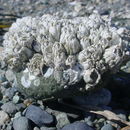Look Alikes
(
Inglês
)
fornecido por Invertebrates of the Salish Sea
How to Distinguish from Similar Species: The sinuous line of contact between the terga and scuta distinguish this species from most other intertidal barnacles. Semibalanus balanoides has a sinuous line of contact but also has no centripetal ridges at the interior base of the shell. Chthamalus dalli has a straight, crosslike junction between the terga and scuta and the rostrum is overlapped by the rostrolaterals.
- licença
- cc-by-nc-sa
- direitos autorais
- Rosario Beach Marine Laboratory
Habitat
(
Inglês
)
fornecido por Invertebrates of the Salish Sea
Mainly on intertidal rocks. Open ocean and protected waters. Also common on pilings and on floats.
- licença
- cc-by-nc-sa
- direitos autorais
- Rosario Beach Marine Laboratory
Distribution
(
Inglês
)
fornecido por Invertebrates of the Salish Sea
Geographical Range: Aleutian Islands, Alaska to Bahia de San Quintin, Baja California; recently introduced at Puerto de Mar del Plata, Argentina.
- licença
- cc-by-nc-sa
- direitos autorais
- Rosario Beach Marine Laboratory
Habitat
(
Inglês
)
fornecido por Invertebrates of the Salish Sea
Depth Range: Intertidal, mostly in the upper half
- licença
- cc-by-nc-sa
- direitos autorais
- Rosario Beach Marine Laboratory
Comprehensive Description
(
Inglês
)
fornecido por Invertebrates of the Salish Sea
A sessile barnacle in which the rostrum overlaps the rostrolateral wall plates on either side of it, the tips of the terga are not drawn out into a beak, the lines of contact between the terga and scuta are sinuous, and the interior of the base of the shell has numerous centripetal ridges. The scuta have a diagonal line of pits. The inner surface of the scuta and terga is black, and especially in small individuals this shows through to the outside as a dark patch in the center of the scutum where the inner surface is excavated into a deep pit and the scutum is thin. The six wall plates are solid, not filled with hollow longitudinal tubes, and do not have fingerlike projecting spines pointing downward. The base is calcified and leaves a calcium deposit on the rock when removed An extremely common intertidal species, especially in the upper half. Diameter to 2.2 cm, but usually 1.5 cm or smaller. The height is usually about equal to the diameter, unless the barnacles are so crowded that they grow very tall and thin. Walls usually white or grayish white, may have longitudinal ribs.
- licença
- cc-by-nc-sa
- direitos autorais
- Rosario Beach Marine Laboratory
Comprehensive Description
(
Inglês
)
fornecido por Invertebrates of the Salish Sea
Biology/Natural History: Often the most abundant barnacle in the upper half of the intertidal zone, and the most nearly ubiquitous barnacle species on the Pacific coast. It can obtain oxygen both from the air and underwater. Barnacles are hermaphrodites which fertilize one another internally by means of a long penis. The eggs are brooded by the parent, and released as nauplius larvae. Up to 6 broods of 1000-30,000 young may be produced per year from this species. After 5 molts the larva becomes a nonfeeding cypris with 6 pairs of legs. The cypris attaches itself to a substrate by an antennal gland and metamorphoses into the adult form. Cyprids avoid rocks which Nucella lamellosa, an important predator, has recently crawled across, and also rocks with the red alga Petrocelis middendorffii. Adult size is reached in 2 years and lifespan is about 10 years, Barnacle molts are frequently seen debris in marine habitats. Predators include oysterdrill snails such as Nucella lamellosa, the ribbed limpet Lottia digitalis, seastars such as Pisaster ochraceous, Pycnopodia helianthoides, Evasterias troschelii, and Leptasterias hexactis, goldeneye ducks, gulls, and even the nemertean worm Emplectonema gracile and the barnacle nudibranch Onchidoris bilamellata. Juvenile rockfish feed on the larvae swimming through kelp beds. Competitors include Semibalanus cariosus and the mussels Mytilus trossulus and M. californiensis, to the shells of which it often attaches. In many areas of the upper intertidal juveniles of this species compete with Chthamalus dalli juveniles by pushing them off the rock. Chthamalus is usually common only in the zone above where Balanus glandula thrives. Less common in estuaries. While it has no eyes, this species is sensitive to light and will rapidly withdraw if a shadow passes over it. Balanus glandula has recently become established in Japan and in Argentina. In Japan it is directly competing with B. albicostatus. The morphology of the feeding legs and penis of this species is highly plastic. Individuals transplanted to high flow areas grew legs which were 50% shorter and 25% wider than those in low flow and their penises were 25% shorter and 50% wider. These differences were not seen between barnacles in high-density vs low-density sites, even though barnacles can only breed with individuals that they can reach with their penis.
- licença
- cc-by-nc-sa
- direitos autorais
- Rosario Beach Marine Laboratory

